This post may contain affiliate links. Please read our disclosure policy.
Mamoul cookies are a beloved Lebanese tradition: fragrant butter cookies filled with walnuts, formed in a special mold. These traditional cookies are not only beautiful and decorative, but they are also rich, buttery, and melt in your mouth!
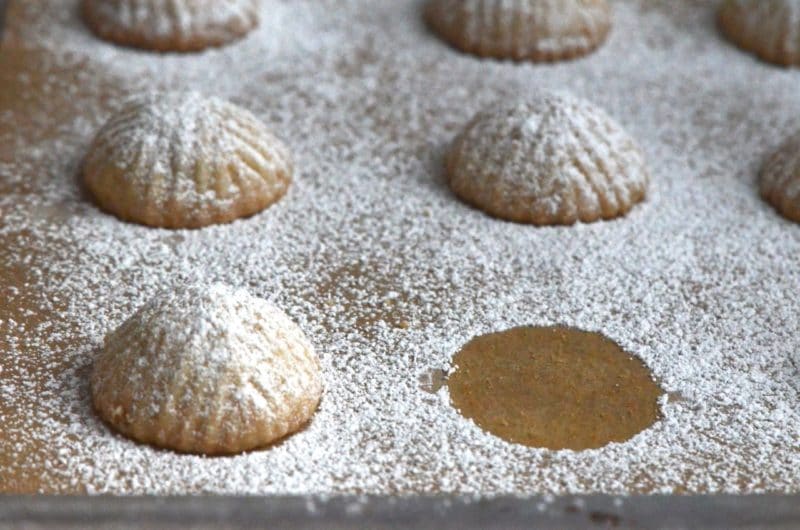
Ma’amoul is a baking tradition we love to keep alive, not only for the pleasure of making them, but because they’re such delicious, beautiful cookies. They are fun to make together with other bakers in the kitchen, and are especially enjoyed to celebrate Easter, Ramadan, and other special gatherings. Mamoul molded cookies come in three classic shapes and flavors and are filled with dates or nuts: flat round date ma’moul, oval-shaped pistachio ma’moul, and domed walnut ma’moul.
Ingredients
- Clarified butter. This is essentially butter ghee, in which the butterfat solids are removed. Clarified butter gives the cookies its prized melt-away texture. If you’ve never made it before, check out this post on how to clarify butter. Be sure to bring the butter to a cool room temperature for this recipe (so it’s essentially the same texture as softened butter).
- Orange blossom water. Use pure orange blossom water for an aromatic floral note in your cookies, very traditional. My favorite, pure orange blossom water in my online shop comes from Lebanon in small batches.
- Vanilla extract. You can use pure vanilla extract or vanilla paste in this maamoul recipe.
- Granulated sugar. While the cookie dough isn’t overly sweetened since it’s filled with sugared nuts and dusted with confectioners’ sugar, there is still a touch of sweetness from granulated sugar.
- Whole milk. Just a splash is needed to help the cookie dough come together.
- All-purpose flour. I like unbleached all-purpose flour.
- Walnuts. Toast the walnuts first for even more depth of flavor in the walnut filling.
- Confectioners’ sugar. Also known as powdered sugar or icing sugar. Dust the baked ma’moul cookies with confectioners’ sugar for sweetness and flair.
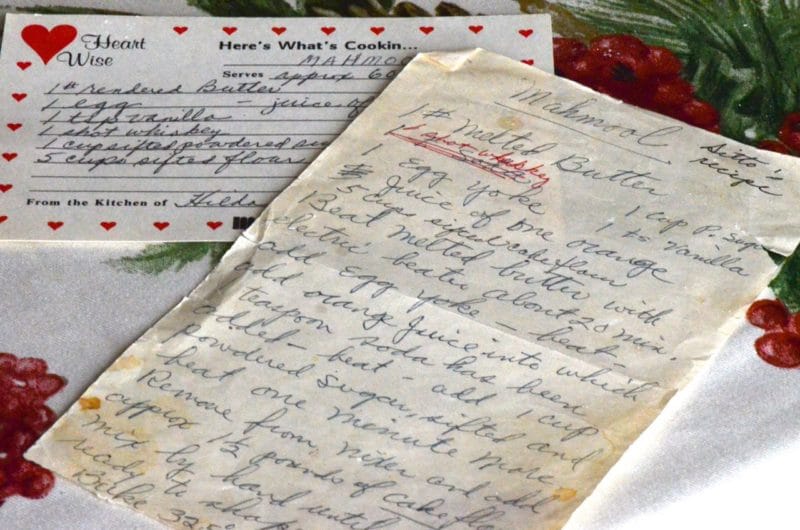
How to Make Maamoul
Step 1: Combine the wet ingredients. Using a hand-held or stand mixer, in a large bowl beat the butter until it is light, fluffy, and holding peaks like whipped cream, about 6 minutes. Add the vanilla, orange blossom water, and 3 tablespoons of the sugar and beat for another couple of minutes.
Step 2: Make the dough. Sift in the flour and gently incorporate it into the butter with a wooden spoon. Add the milk, and then add more flour by the tablespoon until it forms a soft dough. You should be able to make a ball that will flatten in your floured palm without cracking yet doesn’t stick to your hand. Knead it by hand for a minute or two. Chill the dough for 30 minutes.
Step 3: Make the filling. Process the nuts in a food processor until they are almost finely ground. Don’t take them too far or they will become paste. The nuts can also be finely chopped by hand. In a small bowl, combine the nuts with 3 tablespoons of the granulated sugar and 1 teaspoon of orange blossom water, using your fingers to evenly distribute everything.
Step 4: Prepare the oven and mold. Line two heavy baking sheets with parchment or Silpats. Preheat the oven to 325⁰F. Press a bit of the chilled dough in the ma’moul mold to grease it, then flour it generously so that all grooves are coated.
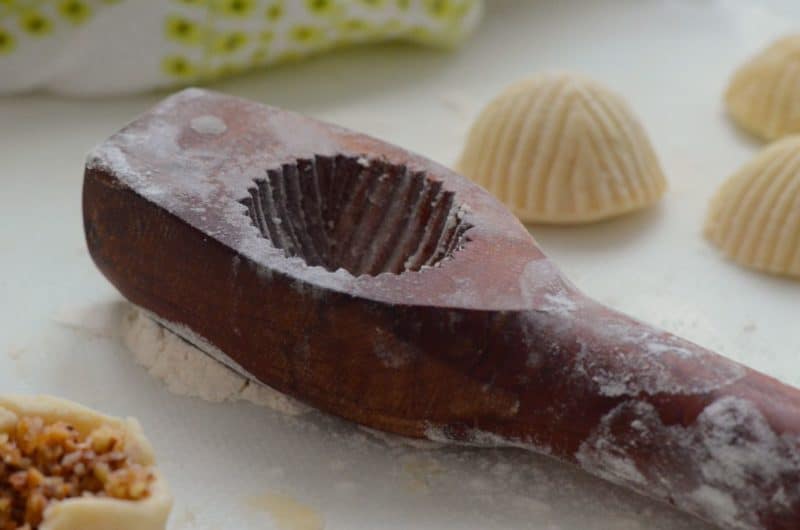
Step 5: Fill the dough. Flour the palm of your hand to prevent the dough from sticking, and flatten about a tablespoon of the dough in your palm to make a small (about 2-inch) circle. You may need to adjust the amount of dough depending on the size of your wooden mold. Place about a teaspoon of the walnut filling in the center of the dough, then fold it over like a crescent and seal the edges. Stretch the dough a little to get the dough over the nuts to seal.
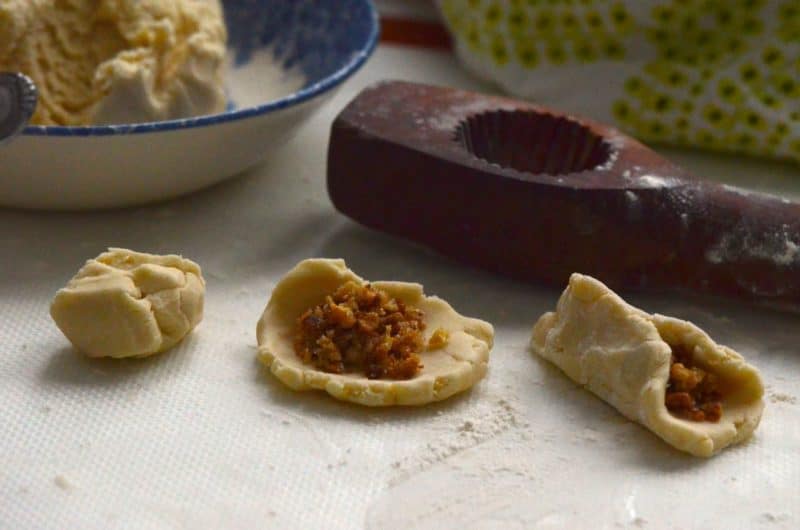
Step 6: Shape the dough. Nestle the stuffed dough seam-side up into the mold cavity. Gently press the dough ball into the mold. Flatten the top and wipe away any excess dough with your fingers, making sure that the edge of the mold is clear of dough. You will get a feel for how much dough your mold takes, and how much filling you need, as you make a few of the cookies.
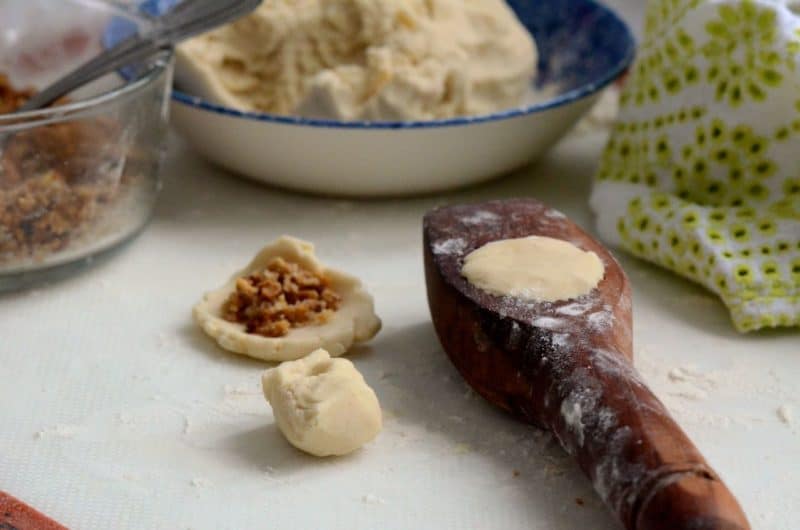
Step 7: Unmold the shaped cookie. Turn the mold over and slam it against the work surface until the cookie falls out. Repeat this process with the remaining dough, moving the shaped cookies to the sheet pans. If the dome of your cookies doesn’t seem tall enough, plump them up by nudging the dough around the base.
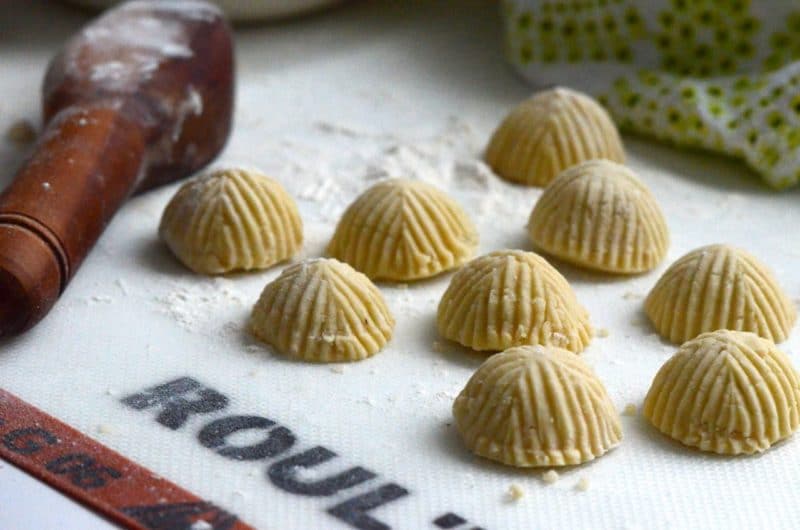
Step 8: Bake. Bake one pan of cookies at a time, until they are still mostly white but golden on the bottom. Check them by lifting one with a flat metal spatula after 15 minutes, and then again every minute or so for about 20 minutes, depending on the size of your cookies.
Step 9: Dust the cookies. Sift confectioner’s sugar over the cookies while they are still warm, and then again when they have cooled.
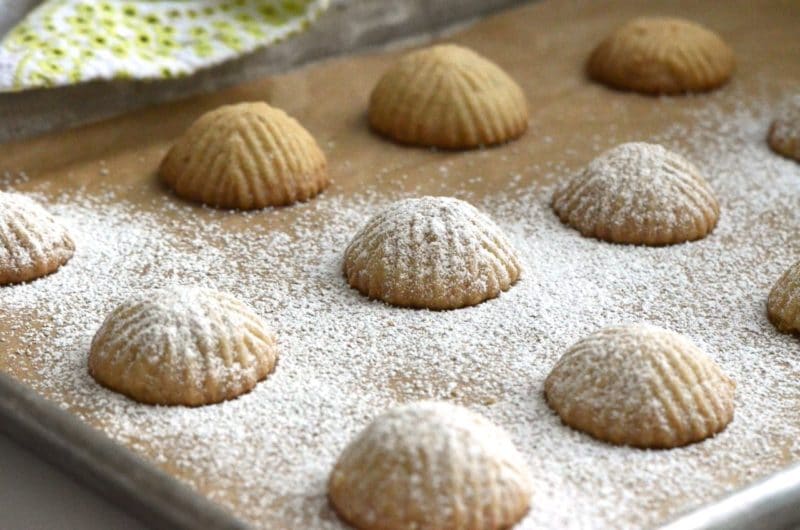
Quick Tips for Making the Best Mamoul Cookies
Use cool room-temperature butter. Make sure your clarified butter is at cool room temperature so it whips up nicely, giving your cookies that melt-in-your-mouth texture. Meltingly soft butter will not get fluffy.
Don’t overwork the dough. Only knead the mamoul dough for just a minute or two. Overworking it will activate the gluten in the flour and make your cookies dense.
Chill the dough. Letting the cookie dough rest in the refrigerator for half an hour allows the gluten to rest and the butter to harden, helping the cookies maintain their shape as they bake in the oven.
Whack the mold. Whacking or slamming the wooden mold against your countertop is the best way to release the cookies from the mold. Don’t try to wedge it out using your fingers or a knife, as the dough is too soft to maintain the beautiful shape the mold created.
Don’t overbake the cookies. Only bake the cookies until you see the edges turn golden to maintain that meltaway butter cookie texture.
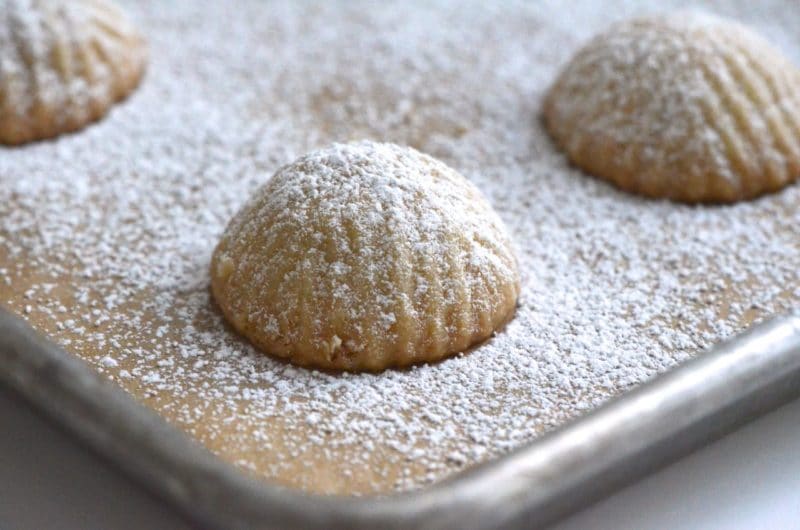
Storage
Storing: Store the mamoul in an airtight container, where they will stay nice for at least one week.
Freezing: You can put them in an airtight container or freezer bag, and store them for up to two months in the freezer.
Ingredient Substitutions
Although these cookies are delicious as they are, here are some ideas for delicious variations:
- Date filling. Dates are another classic, delicious filling for mamoul cookies and a great nut-free option. My Sitto’s date mamoul recipe has its own way with ma’amoul and is a favorite.
- Use a variety of nuts. Pistachios are excellent in place of the walnuts, and we enjoy toasted pecans here, too.
- Semolina flour. It’s traditional to use semolina flour as well as all-purpose flour in these shortbread-style cookies. You can substitute half of the all-purpose flour with fine semolina.
- Orange juice and whiskey! These are ingredients Sitto includes in her ma’amoul recipe, fun! Add a tablespoon of orange juice and a tablespoon of whiskey to the recipe along with the orange blossom water. If the dough feels too soft after mixing, add a tablespoon of flour.
- Rose Water is another beautiful, floral flavoring often included in ma’amoul. Either use it in place of the orange blossom water, or combine the two using half rose, have orange blossom.
In this recipe

Walnut Ma’moul Cookies
Ingredients
For the dough:
- 1 cup (8 oz.) clarified butter, cool room temperature
- ½ teaspoon orange blossom water
- ½ teaspoon vanilla
- 3 tablespoons granulated sugar
- 1 tablespoon whole milk
- 2 cups all-purpose unbleached flour, plus a few tablespoons for the mold
For the filling and finishing:
- 2 cups walnuts, toasted
- 3 tablespoons granulated sugar
- 1 cup confectioner's sugar
Instructions
- Using a hand-held or stand mixer, beat the butter until it is light, fluffy, and holding peaks like whipped cream, about 6 minutes. Enjoy the beauty. Add the vanilla, orange blossom water, and 3 tablespoons of the sugar and beat for another couple of minutes.
- Sift in the flour and gently incorporate it into the butter with a wooden spoon. Add the milk, and then add more flour by the tablespoon until, as Sitto says, “the dough is ready to shape.” That means you should be able to make a ball that will flatten in your floured palm without melting into your hand or without cracking. Get your hands into the dough and knead it for a minute or two. Chill the dough for 30 minutes.
- Make the filling by processing the nuts until they are nearly-finely ground. Don’t take them too far or they will become paste. The nuts can also be finely chopped by hand. In a small bowl, combine the nuts with 3 tablespoons of sugar and 1 teaspoon orange blossom water, using your fingers to evenly distribute everything.
- Line two heavy baking sheets with parchment or Silpats. Pre-heat the oven to 325⁰F.
- To form the ma’moul, I like to press a bit of the dough in to grease the mold, then flour the ma’moul mold generously so that all grooves are coated. Pinch off about a tablespoon, walnut-sized piece of the chilled dough (larger or smaller depending on the size of your mold. A few tries will tell you how much to use). Flour the palm of your hand to prevent the dough from sticking, and flatten the dough in your palm to make a small (about 2-inch) round. Place about a teaspoon of the walnut filling in the center of the dough, then fold it over like a crescent and seal the edges. Stretch the dough a little to get the dough over the nuts to seal.
- Gently nestle the stuffed dough, seam-side up (facing you), into the mold cavity. Using a light touch, press the dough into the mold—it doesn’t take much for the dough to assume the form of the mold. Flatten the exposed dough and wipe away any access with your fingers, making sure that the edge of the molded shape is clear of dough, for a defined cookie edge. You will get a feel for how much dough your mold takes, and how much filling you need, as you make a few of the cookies.
- Turn the mold over and slam it against the work surface until the cookie falls out. If you need to keep slamming to work out any stress in your life, have at it.
- Repeat this process with the remaining dough and cookies, moving the cookies to the sheet pans. If the dome of your cookies doesn’t seem tall enough, plump them up by nudging the dough around the base of each cookie in a bit.
- Bake one pan of cookies at a time, until they are still mostly white but golden on the bottom. Check them by lifting one with a flat metal spatula after 15 minutes, and then again every minute or so for about 20 minutes, depending on the size of your cookies.
- Sift confectioner’s sugar over the cookies lightly while they are still warm, and then again when they are room temperature. Store them in an airtight container, where they will stay nice for at least one week.
Video
Notes
Nutrition
Nutrition information is automatically calculated, so should only be used as an approximation.

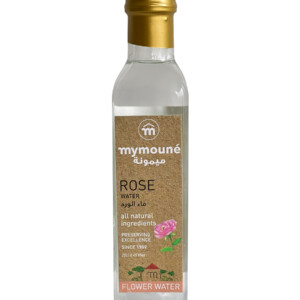
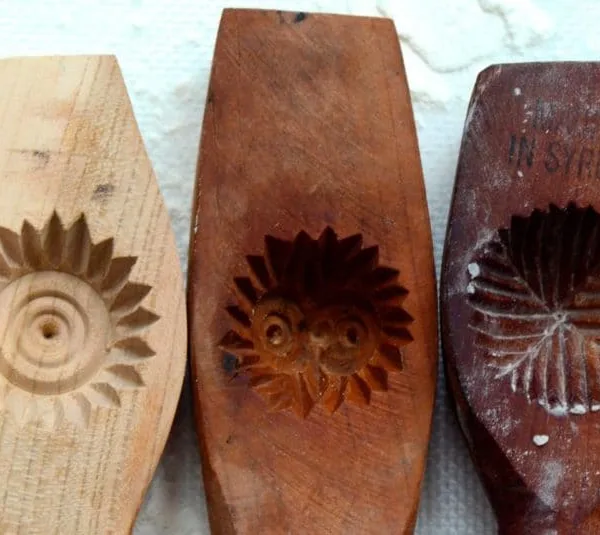
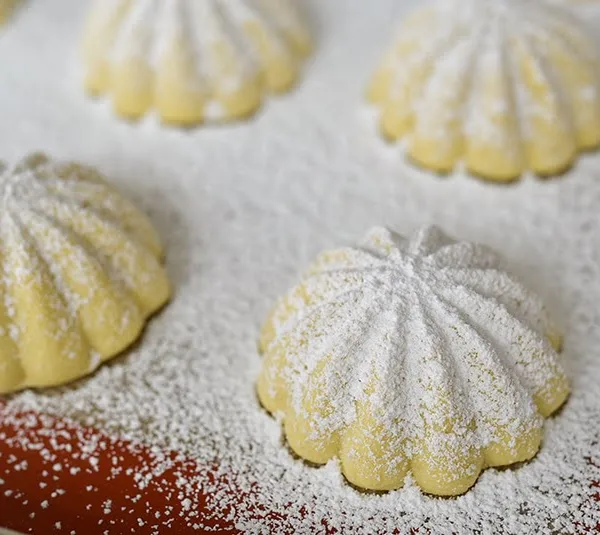







Maureen, I jumped to Video on the recipe card but there is no video. Is it just me??
Hi Rickeia! Yes, you will find the video in the recipe card under the recipe. Maybe try refreshing your browser to get it to show up?! It’s there for you and very fun to see the shaping!
Maureen, do you have a video of this recipe?
Thank you Christine, on its way!!
Thanks Maureen! By the way-a friend of mine’s mother (deceased now) was a “Shaheen,” (Sylvia), and had relatives in Michigan. I wonder if she was related to Dan??? – Interesting. Happy Easter:)
Video is here, in the recipe card!
I have your cookbook and love the fact that your recipes are so similar to how my family makes them. I fell in love with your blog when I first read your description of your father making kibbeh. Brought back so many memories of my Sitoo. My reason for this note is that she made her cookies with Farina and a very small amount of flour. The dough sits for about 4 hours absorbing all the wet ingredients. Makes a very wonderful texture and taste. Perhaps she did not have access to semolina when she arrived here? She was from the Masser el-chouf region. Thank you for all you share!
Kathleen this is so so touching. Thank you for your kind words. Yes, very traditional to make the ma’moul with semolina (coarse semolina, or farina). Many in our communities here, and in many cookbooks, use flour only and it may well be scarcity of semolina that started it!
My recipe uses semolina? I like the taste and flavor.
Oh yes, that’s a great way with ma’amoul and traditional as well. I have developed that recipe and will share here soon.
Hello Maureen… am 2nd Generation but never was exposed to major Middle Eastern cooking until I became the President of local Syrian-Lebanese club…. My immigrants are fabulous because they have all the ‘trade secrets’ of a truly ethnic lifestyle.
Here’s a TIP on easier usage of the wooden mold (think you will like it Chef). As I was going through an evening school with my cousin sponsored by some wonderful sisters (one is chef trained)… there comes the time to “load the mold”. The ‘sister chef’ leaves the room and comes back with some packages of knee high hosiery….. hmmm this is going to be veerrrry interesting…. The scissors come out and the footie area is lopped off!!! Hmmm…. then wahlah… the hose is put onto the mold and we proceed the loading process.
Would call this a piece of cake but it was so much more delicious than that!!! Please pass this on if you feel it being worthy.
Love your cookbook and your constant newsletters… have passed it onto so many kin and folks who love our food. God bless you and your family through this Season with a Reason.
Rae-Lene Wolf née Dib
Mahfoud/Boustany Clan Member
President – Cedars of Lebanon of Little Rock, AR
Affiliate of Southern Federation of ASLAC
What a great note, thank you so much! I learned that method from others like you who work on large scale ma’amoul baking! Great tip and I look forward to testing and sharing too.
Hi Maureen
I graduated from AUB decades ago because my Father was working in Cairo. Don’t have Lebanese roots but loved the food, especially fatayer. Am waiting for my order of ma’moul mold, orange flower water, mahleb, and the round mold to make ka’ik. I love anise flavor so look forward to making the biscuit cookies. I’d like to try the date filling for the mah’moul. Would I use the same filling suggested for ka’ik? Should I use both vanilla and mahleb, or choose one or the other?
How special Victoria! You can find the ma’moul date recipe (my Sitto’s!) here on the site here. It’s essentially pureed dates or date paste. For the flavoring, I like both the vanilla and the mahleb!
Hi Maureen
I do enjoy reading your recipes. Keep up the good work.
I used to have a successful pastry business based on making mamoul in the thousands as wedding favours.
I will not comment on your recipe as recipes can differ.
The pointer I would like to give is for the molding. Cover the mold in a fine cut off lady’s stocking . Slip the mold into the stocking, I used the knee high stockings, stretch the stocking and tie to the mold handle to fix it in place. You can also use a piece of stocking to cover the front of the mold and tie the piece at the back of the mold and at the handle.
With the stocking you will not need flour and the mamoul will never stick to the mold nor will the mold ever get clogged.
I hope this will make your mamoul making easier and more pleasurable.
Rida, this is fantastic!! Thanks so much for taking time to share your method for molding ma’moul, and for your kind words!
I just made these for Christmas. Used your dough recipe – thought it could have used a pinch of salt, also instead of using flour as a mold release I used granulated sugar which worked wonderfully.
Hi Maureen,
Love the recipes! My family came from Syria. Instead of the molds, they would shape the dough in a long rectangle, fill with the nuts, cut on a diagonal, use a special tool for the design, then bake. After baking, would pour simple syrup over. Date cookies were crescent shaped.
Those sound beautiful Elizabeth, thank you for sharing!
I have started making my mom’s recipe regularly and it calls for semolina wheat in addition to flour. Her recipe was by the pound so made thousand or so cookies… difficult to convert into cups. She and her sisters would get together every Christmas to make them to hand out to friends and family. I love that my mom passed on this tradition. Thank you for this wonderful blog! The dough also freezes well and makes it so nice to be able to make a few dozen at a time.
What a great recipe you have from your mother, and I love how everyone baked together! Thank you Michelle!
Hi, was wondering if the butter can be replaced with oil or shortening?
Thanks.
Hi Alisha–interesting question. I have not tried the ma’moul with those substitutes. I suspect shortening would work better than liquid oil, as often shortening is called for in butter cookies (or it used to be, according to my Betty Crocker cookbook!).
Yikes I hit Send by accident and I wanted to ask: If the small round mold is traditionally has a walnut filling, what are the traditional fillings for the oval shape and the larger, flat circle shape?
Hi! The oval is traditionally pistachio, and the flat circle, dates!
Thank you Maureen
I will try again
I love your recipes. I will try this week the Fatayer
Best regards
Hi Maureen
I tried your recipe twice and family loved it – my it is very similar to my mother’s
I had some difficulties with the consistency of the dough
I need your advice: what to do when it is too soft and what do you do when it is cracking. It kept sticking to the mold
Your input will be greatly appreciated
I love your recipes
Eva
Hi Eva–thanks so much. That can certainly happen with the dough. I add the flour slowly so that I can be sure I don’t take the dough too far and make it dry. You can add milk very sparingly to get the dough back to a softer consistency if needed. If it’s too soft, add flour again very sparingly as these changes can affect the flavor and texture of the cookies. You might also clean the mold, then brush it with oil before shaping the cookies.
Hi Maureen,
My mother always dipped the cookies in a simple syrup, while warm. They are so delicious! Everyone goes wild for these cookies. Just tried them with gluten free flour and they are still to die for! I add cinnamon to my walnut mixture. Yum.
Thank you for your wonderful recipes!
Hi Maureen,
Very early in the comment section, someone suggested a video would be a good help for this recipe. I couldn’t agree more, and actually, if you could/would show filling the mold your way a few times; then show filling the mold using the stocking method… that would be very encouraging for us newbies to these great looking cookies.
One more “maybe” suggestion having to do with wooden kitchen tools. You can purchase Mineral Oil (in drugstore) which is a extremly fine (flavourless) oil, that is totally food-safe and does miracles in keeping all wooden tools in excellent shape (simply so things don’t dry-out and crack/split) by simply oiling your tools after uses, and those tools eventually become “seasoned” when oilings are maintained. So, my point is, in reference to your molds, this may also be a solution to aid in seamlessly releasing the moulds.
Wonderful thoughts Mare, thank you very much. I love mineral oil and agree it’s a wonderful treatment for wood in the kitchen. I’ll get that how-to video up here soon!!
Video is here, in the recipe card!
I just bought 2 molds, one for walnuts the other for dates and I’ll be trying my hand for the first time at both this year. Do the molds need to be seasoned at all before using them? Thanks for sharing your recipe, I’m looking forward to making these and hope that I don’t eat them all myself!
Hi Lisa–good question. The mold should be well-floured for each cookie so they release, and once you make even one cookie the flour will stick nicely. I press some dough in and take it out to get new molds oily at the start.
The substitution of whiskey and juice of a real orange seems like a perfect combination for a holiday treat. Any chance you could supply that as another option in the Mo’moul recipe?
Thanks Deena–keep an eye out for it, I’d love to share it down the line here!
i, too, love the stained handwritten recipes. so beautiful, lovely memory evoking treasures.
I made the cookies ….with dates (using cookbook recipe) just last week. Wanted to do a trial run before Easter. I actually did wonder about the sugar, but figured it out that the other 3 tablespoons were for the nut filling. I agree the oven temperature is too low, and time too short. I actually baked them again the 2nd day. They still looked a little ‘anemic’, so tried a couple of minutes under the broiler. That just browned the top. Maybe when I dust them with icing sugar that will work. Liked the taste and texture of the cookie, but did taste more like a ‘shortbread’ to me. Since I have not made the cookies before, I had nothing to compare with. Love orange blossom water and will likely increase it for next batch. Love your videos and blog……..as well as cookbook. Many thanks.
Great feedback Linda, and this really is more of a shortbread cookie flavor than some ma’mouls (there is a classic semolina flour version as well). Thank you!!
My name is Hilda and I am Lebanese but I’m not your Aunt! However, I’ve been making these Maa’mul since I was a tyke, helping mom and aunt with them and later, my own. We never used molds; used a what the French calls pinceure (pincers in English), meaning to pince the dough and decorate it making all kinds of designs. Ma’amul decorated by hand are a treasure!
Oh wow, yes, I’m sure the hand-decorated ones are so lovely. This is how we always decorated ka’ik, not with a mold.
I just got my mold and the recipe. Would you also share the version with whiskey and orange? Thanks so much!
Thanks Nancy…I’ll keep you posted on this!
Thank you for this recipe. I just finished making my Sitoo’s recipe. Her Mamoul were a farina based dough. This recipe is very much like the one she made and filled with ground dates with a little butter and shaped them like little footballs. I so enjoy your blog. It brings back so many wonderful childhood memories for me. Happy Holidays to you.
Great recipe! Do you know where they sell those wooden molds? Id love to try and make these mamoul.
Hope to have them soon at Maureen Abood Market! Stay tuned!
I enjoyed reading about your maa’moul recipe. I just finished making two dozen date ones for an iftar function and they were a hit. I made mine with semolina and flour which turned out pretty good. Everyone was surprised that this old lady from Texas could make these.
Thanks so much, Maureen! I would really like to try these cookies. My best friend, who is of Greek and Lebanese decent, and I make several pans of baklava together every Christmas for gift giving.. These cookies would be a great addition to that tradition. I’m so disappointed that I’m going to miss your presentations at Zingerman’s in May. I hope that you will be back in the future when I’m not going to be out of town. Thanks.
I’m so excited about making ma’moul mold cookies. Do you have any suggestions for sources for buying the molds? I didn’t have much luck with the links in your article about the cookies, probably because they are old links. Thanks.
Teresa, thanks–I’m working on offering a great mold at Maureen Abood Market. Sorry for the links, will keep you posted!
You’ve become my go-to for recipes! Thank you for sharing your knowledge. My great aunt used the flat backside of the mold to flattened the dough ball but my grandmother rolled hers out. It’s possible to roll 2 or 3 at a time. Both placed the flattened dough over the mold before stuffing with the nut mixture. I measure the fillng with a plastic coffee scoop that came with a coffee pot. It’s slightly smaller than a regular scoop which is 1/8 cup. To avoid them getting stuck in the mold, I press the flattened dough onto a pastry board covered with sugar. Only need 1-2 wacks on the board & sugar doesn’t clog the design the way flour does. I made some with pecans using the shallow date mold so no one confuses them with the walnut one — they taste great.
Great tip! I will try the ma’moul with sugar! Pecan also sounds delicious…thank you!
Would these cookies freeze well if I needed to make several batches?
Absolutely Jessica, in an airtight container, well wrapped for the freezer, these will freeze beautifully.
Hello. I’ve been roaming around here since yesterday. Nice stuff although I am familiar with the most as I am Lebanese living in an Arab country and of course visiting Lebanon few times a year.
Having said that, I’ve never seen any of the ladies I know preparing Ma’moul this way. My mom, God mercy her soul.. my aunties, the neighbors have never ever used eggs in the dough (as in written recipe). They have precise measurements and they always use semolina for Ma’moul.. never flour.
Looking at other recipes shared on this page.. I am sure this Ma’moul is another story. I guess I need to try to know.
Thank you so much for sharing all these delights.. the Lebanese cuisine is just full of deliciousness
Hala, thanks so much—there are many traditional recipes for the semolina; my family and some of my old-school cookbooks use flour, which I hope you enjoy trying!
Hello Maureen,
Thank you for the stress relief tip 🙂
I am looking forward to my holidays to practice.
I’ll try your recipe – I am sure it will be a success if I bake them right.
I will only use “mahlab” instead of vanilla.
Thank you very very much for your words. They are good for the soul and for the stomach.
J.
Jamila, thank you so much. The mahleb is very good in this!
Don’t forget to leave the powder sugar off the Ma’moul you stuff with dates! It’s the only way to tell the difference…
I have purchased some new molds for the Ma ‘moul, but none are better than the one my mom used, the same one you show in the pictures!
You could at least give us those old family recipes. We could choose between the orange juice and the shot of whiskey..
Have a Merry Christmas Maureen!
Hi Maureen. Really nice recipe, thank you!
For those that do not have a cookie mold, my (Lebanese) grandmother made a similar cookie around Christmas every year, except they were called “half moon cookies” to us. She made them by flattening out a small disk of dough – maybe about palm-sized – placing the filling on one half of the disk and then folding the other half over and crimping down with a fork. You can see where the cookie name came from.
Hope that helps a reader who may not have the required tool!
My Lebanese grandmother did the same thing. She stuffed hers with chopped dates. I would be curious if anyone else had these cookies with dates instead of nuts. Might be a locale thing. Happy New Year to all!
‘Enjoy the beauty’-how lovely, and, these look exactly like my grandmother Nassir’s- I too appreciate your handwritten recipe–i have those dating from decades ago until i finally processed them into Word on my desktop just a few months ago–but–I kept the paper-nice memories of time spent with my mother when I was getting ready to leave her home and go on my own–
MO!!!!!!! i LOVE these cookies! my mother’s side of our family hails from scandinavia & i have sooooo many cookie recipies using the molds! i only wish i had some of my great gramma severina’s wooden ones 😉 she only brought her recipes & her baking gadgets & a small bag of clothes when she & my great grampa came through ellis island from etne, norway 😉 and as always i LOVE your words, your passion, & your photos <3 tammy
Tammy, how neat. I would love to try the Scandanavian molded cookies.Your grandmother was smart to bring the recipes!! A treasure. Thank you, as always, for your kind kind words!
Thank you Maureen. They look delicious!
I love the beat-up recipe written out on paper. I’ve got lots of those.
Advent Blessings,
Jim
Thanks to you, I now know the wooden tool I found in my recently-passed Gram’s kitchen (that I was sure was a strange looking juicer) is actually the mold for my favorite cookies! Can’t wait to make some using it to honor her memory. Merry Christmas!
Where can I get mold?
Thank you!
Alan, I offered beautiful molds in my shop and am out, hopefully temporarily. You can find molds (inferior quality but still a mold!) in Middle Eastern shops and online, though I haven’t found any good enough to recommend…which is why I was having them custom-made. Soon again I do hope!
These look more than wonderful. I have never had these. Can’t wait to try them